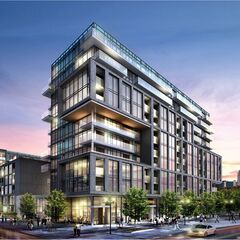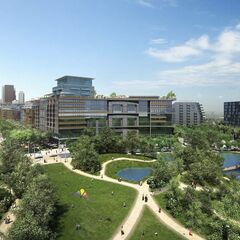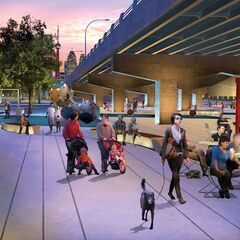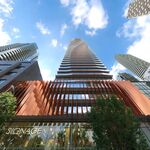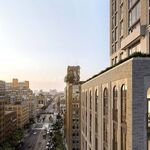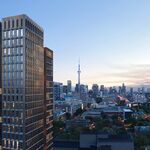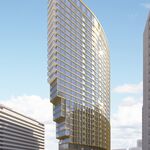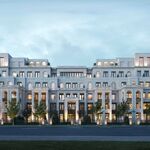Toronto will see something extraordinary happen in the West Don Lands in 2016: a whole neighbourhood will be born over the course of about six months.
Starting that March residents will begin to arrive, and by the time the new school year hits in September 2016, 3,000 people will live, work, shop, eat and play in a number of new buildings stretching across several blocks. There will be shops, restaurants, a park, a main street promenade, public art, a great park, and even a new TTC streetcar service.
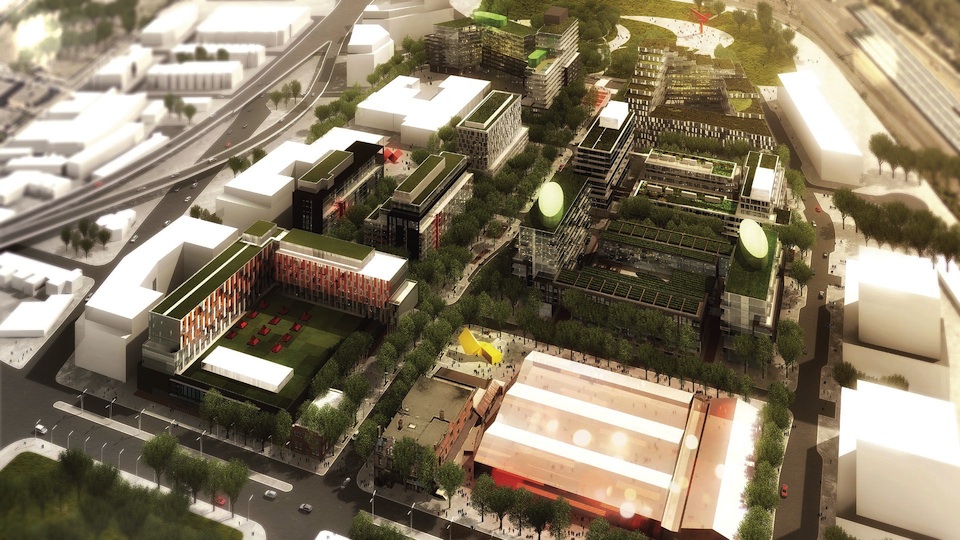 Aerial view of the Canary District with PanAm Games tent, image courtesy of DundeeKilmer
Aerial view of the Canary District with PanAm Games tent, image courtesy of DundeeKilmer
That might sound like wishful thinking, but there are unique circumstances here and a unique plan in place to make this rather remarkable goal come about.
Included in Toronto's bid for the 2015 Pan and Parapan Am Games was the decision was to build the athlete's village here, and in the time since having won the bid on Nov 6, 2009, the race has been to make the area work both during the games, and as a new city neighbourhood ever after. Today, developer DundeeKilmer is happy to announce that with a year and a third to go, the PanAm Village is on time (despite this crazy winter) and on budget. 82% of all the work is done, and that includes factoring in the area's post-games conversion into a functioning neighbourhood… a new neighbourhood DundeeKilmer hopes we will refer to as the Canary District.
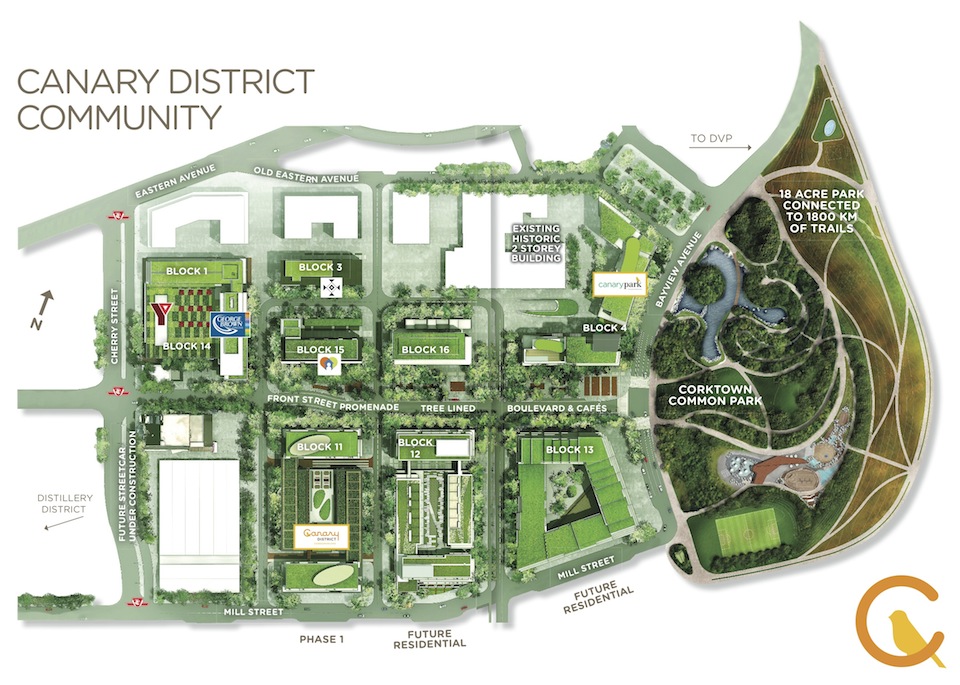 Site plan for the Canary District, image courtesy of DundeeKilmer
Site plan for the Canary District, image courtesy of DundeeKilmer
The area has taken on a few monikers over the last few years so that it's not known for certain which one the public will stick with in the end, but DundeeKilmer has their heart set on one that recalls The Canary Restaurant, long a fixture at Front and Cherry Streets, since closed, and which is now commemorated in the names of the first two market condominium complexes on sale in the area; the KPMB-designed Canary District and Canary Park. The former is now over 80% sold, while the latter will have its sales launch this May.
Those two projects bookend the current construction at the extents of the coming Front Street promenade, with affordable housing, George Brown College's first student residence, and a new YMCA facility coming to fill out the rest of phase one. (Blocks 12, 13, and 16 seen in the image above will be built as part of a following phase.) We do not yet know how or when the Canary Restaurant itself will be reborn—its building is under the stewardship of Waterfront Toronto—and an announcement regarding its future is likely a while off.
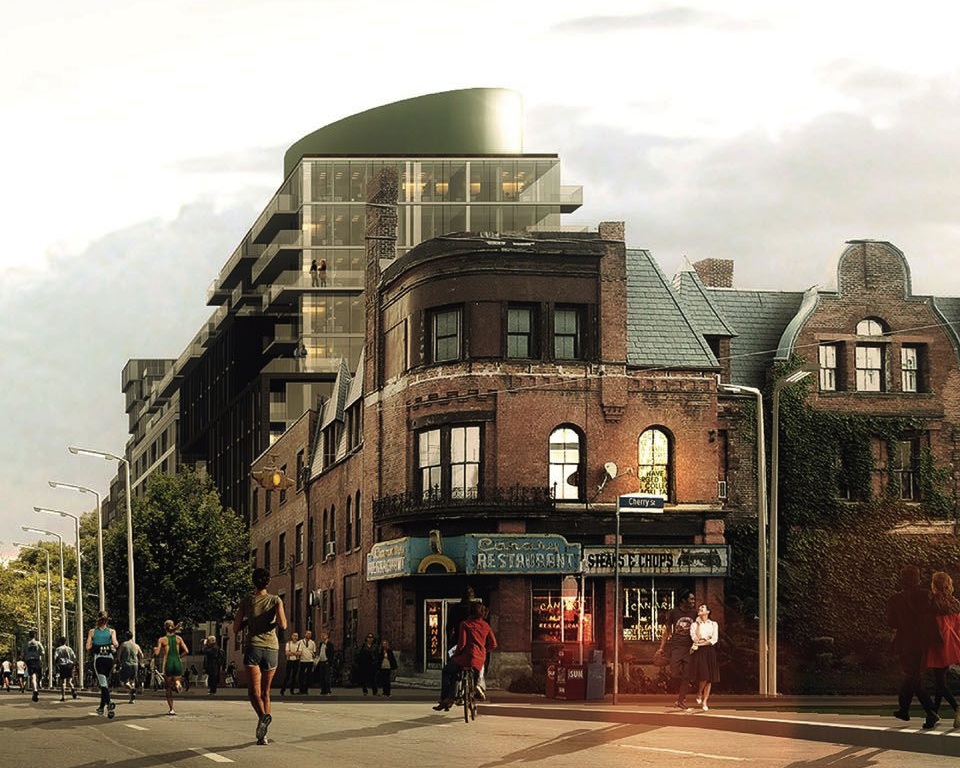 The Canary Restaurant: will it open again? Image courtesy of Waterfront Toronto
The Canary Restaurant: will it open again? Image courtesy of Waterfront Toronto
If such a cold winter had to happen during the lead-up to the games, this was the year to have it as far as those building the district were concerned. Most of the exterior work on the buildings is already done—the last crane came down a couple weeks ago—and this winter's work, with about 650 people on site daily at the moment, has been largely inside where it's warm.
The buildings being finished up now are those which will house 10,000 athletes, coaches, and team officials during July and August 2015. Spaces that will become 1 bedroom condominium suites post-PanAm will house on average 5 athletes during their two-week-long games stays. Kitchens are not going into the suites before the games—the athletes will eat in a giant communal tent structure to be built at the west end of the site—and neither is the final flooring. Instead, the units' concrete floors will be sealed, and temporary partitions will create more bedrooms. Amenity spaces will be ready as common areas for the athletes, but won't feature their final finishes.
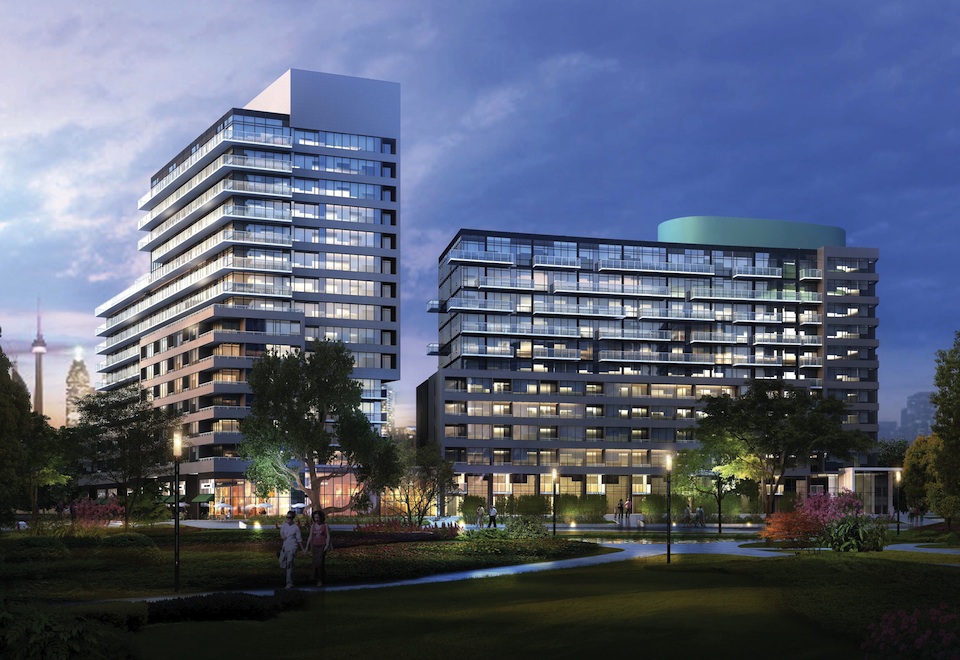 Canary Park Condominiums, image courtesy of DundeeKilmer
Canary Park Condominiums, image courtesy of DundeeKilmer
After the games, the developer has 6 months to take down the temporary partitions, install the kitchens, put in the final flooring, and refinish the common areas. DundeeKilmer is aiming to have about 4 units occupy per building per day starting in April 2016. When the residents move in they will find that common elements will be 100% done, as will the landscaping around the building. Shops and cafés will have replaced chef de mission games-related offices at ground level. Pioneers of a new neighbourhood as they will be, the first residents won't feel like they are moving into a construction zone as is so often the case.
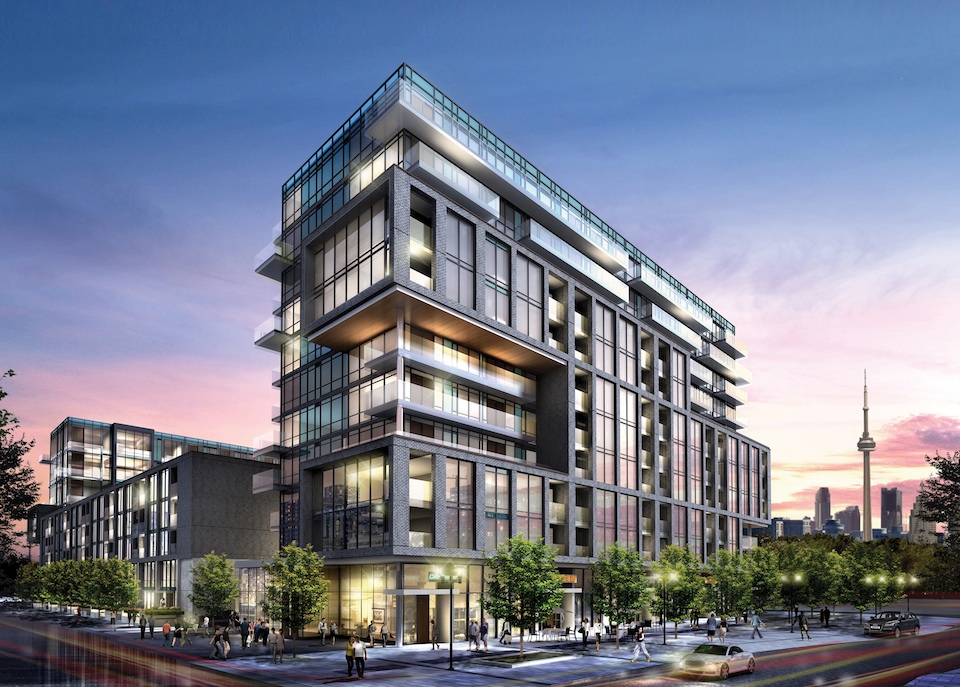 Canary District Condominiums, image courtesy of DundeeKilmer
Canary District Condominiums, image courtesy of DundeeKilmer
It's DundeeKilmer's intention that all of the retailers be open by July 2016, and to accomplish that they have hired one of Canada's foremost retail strategists, LiveWorkLearnPlay. Having created and implemented the retail strategies for the villages at Whistler, Mont-Tremblant, and Blue Mountain amongst many other master-planned developments, LWLP are looking to create a Health and Wellness themed retail destination within the Canary District. While those resort villages focused on serving visitors, and while the adjacent Distillery District has a focus on the arts, culture, fashion, and the home, retail here will focus on residents' needs, and those drawn to the area by its recreational facilities such as the brand new YMCA and the bicycle trails along the Don Valley and Waterfront which meet at Corktown Common. Finding a good independent bike retailer, for instance, is as much of a goal for the neighbourhood as is getting a mix of cafés and other local retailers in place for residents in the earliest days.
 Looking west on Front Street from Corktown Common to Downtown Toronto, image courtesy of Waterfront Toronto
Looking west on Front Street from Corktown Common to Downtown Toronto, image courtesy of Waterfront Toronto
In total, the 35 acre community will include 43,000 square feet of ground floor retail in total, with 30,000 square feet opening in the first phase. Besides the bike store mentioned above, LWLP and DundeeKilmer intend to set the neighbourhood's tone with a cluster of independents like a runner's store, a yoga studio, and other recreation destinations which will draw from the greater area. To meet the neighbourhood needs, at least one retailer specializing in prepared foods is expected to complement the good number of grocery stores already in the surrounding area.
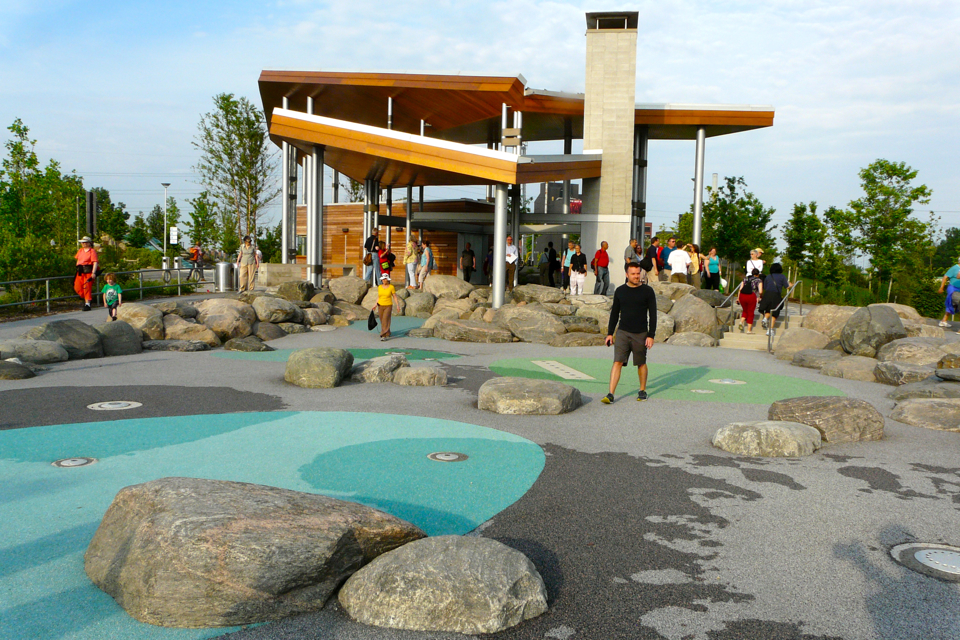 Pavilion in Corktown Common, image by Craig White
Pavilion in Corktown Common, image by Craig White
We have already seen the results of investment in the public realm in the area with the opening of the first phases of Underpass Park and Corktown Common, two acclaimed public spaces which will both see their second phases open in 2014. By the time the Canary District is a neighbourhood, there will be plenty more public realm to celebrate. Carefully and artfully selected trees are already being planted along the area's new streets (we will have a full story on that aspect alone later this year), all going in to specially prepared silva cells which provide lots of room for roots to spread out. The cells have proven to be very successful at Corus Quay over the last few years, and promise a leafy canopy here too.
 One of the winning proposals for the Front Street Public Art Commission, Lamppost by Tadashi Kawamata
One of the winning proposals for the Front Street Public Art Commission, Lamppost by Tadashi Kawamata
Public art will play a major role in neighbourhood identity here as well. Mark di Suvero's No Shoes already enjoys a prominent position in Corktown Common, and the Front Street promenade will have at least three major pieces. Tadashi Kawamata's Lamppost, above, is one of two pieces announced for the wide pedestrian space through the centre of the neighbourhood so far.
There's more to come before of course, and lots to happen here before residents move in, and even before the athletes make their visit. A chance will be coming up soon for Torontonians to introduce themselves to the new streets, and we will let you know more about that when the details are ironed out. In the meantime, UrbanToronto has several dataBase files covering many aspects of the area, all with plenty of renderings and further details. They are all linked below for your perusal. You can get in on any of the discussions in the associated Forum threads of course, or leave comment in the space provided on this page if you so desire.
| Related Companies: | architects—Alliance, Baker Real Estate Incorporated, Dream Unlimited, EllisDon, LiveRoof Ontario Inc, Snaile Inc. |

 3.2K
3.2K 



